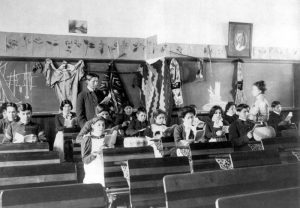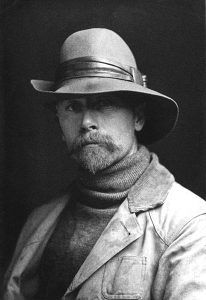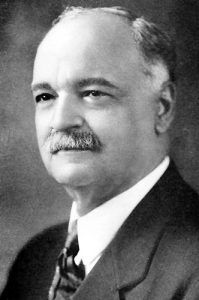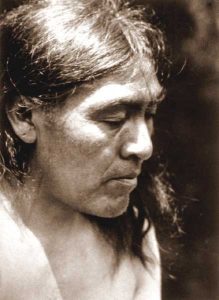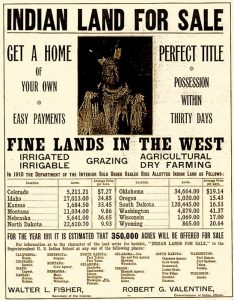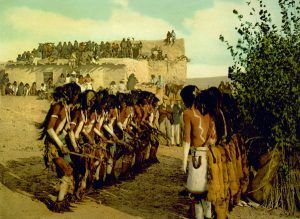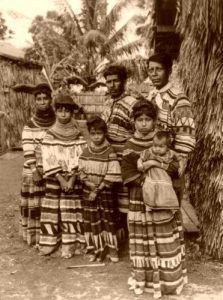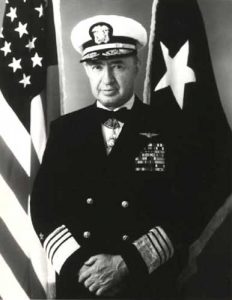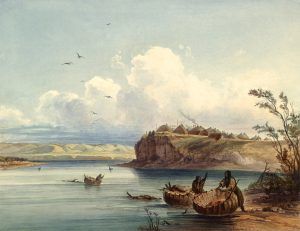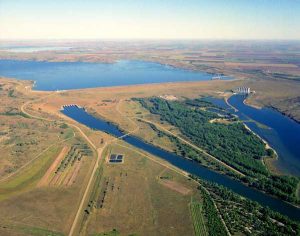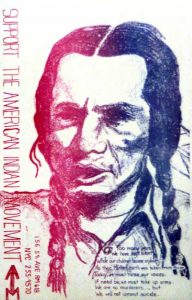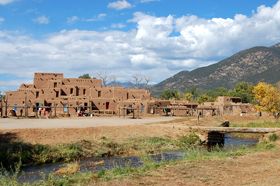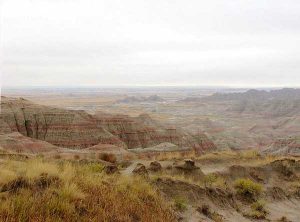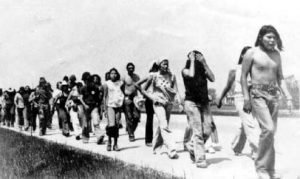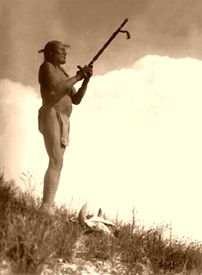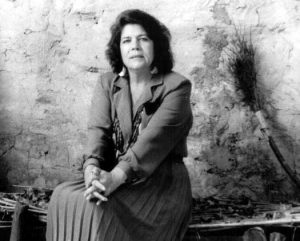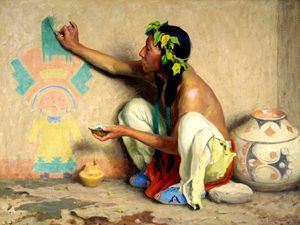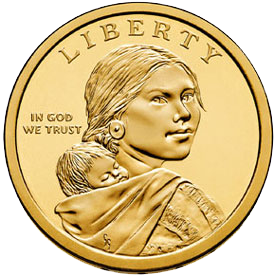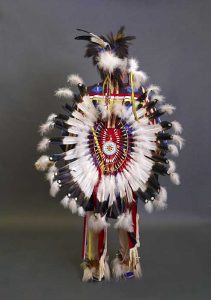“Tell me, and I’ll forget. Show me, and I may not remember. Involve me, and I’ll understand.”
— Tribe Unknown
As the United States moved into the 20th Century and the Indian Wars were a thing of the past, the initial effort of the nation was to assimilate the Indians into American culture. This required stripping Native Americans of their culture and traditions and forcing them to conform to the new way of life. The job of the Bureau of Indian Affairs was to bridge the gap between the Federal Government and the Indian tribes by continuing to make treaties and assimilate the Indians to coexist with Americans.
However, by 1934, these efforts had failed, and the Government passed the Indian Reorganization Act to reverse the traditional goal of assimilation of Indians and to strengthen, encourage, and perpetuate the tribes and their historic traditions and culture. While this helped, the memories of past injustices were ever-present. In the next decades, the U.S. passed more laws to move Native Americans into mainstream American society. By the 1950s, Congress sought to abolish tribes, relocate American Indians, and pass a federal policy of termination. From the government’s perspective, Native Americans were to become taxpaying citizens, subject to state and federal taxes and laws from which they had previously been exempt.
However, a Native American Civil Rights Movement began, which increased awareness and propagated a political agenda, and numerous lawsuits were filed in the second half of the 20th century to correct the wrongs made in the previous centuries.
1900-Present
1900 – Edward S. Curtis, a Seattle-based photographer, accompanied ethnographer George Bird Grinnell to a reservation in Montana and took photographs of Blood, Blackfeet, and Algonquin Indians who were gathered there for their annual sundance.
1903 – Lone Wolf vs. Hickcock Supreme Court decision. The Kiowa and Comanche sued the Secretary of the Interior to stop the transfer of their lands without the consent of tribal members, which violated the promises made in the 1867 Treaty of Medicine Lodge. The Court ruled Congress could, by statute, repeal the provisions of an Indian treaty.
1906 – The Antiquities Act was passed, which declared that Indian bones and objects found on federal land were the property of the United States.
In 1906, photographer Edward S. Curtis announced plans for a 20-volume work documenting Western Indians. His first volume was published in 1907, and the last two volumes appeared in 1930.
The Burke Act amended the Dawes Act to give the secretary of the interior the power to remove allotments from the trust before the time set by the Dawes Act by declaring that the holders had “adopted the habits of civilized life.”
1907 – Congress established the State of Oklahoma by merging Oklahoma Territory and Indian Territory. The former Indian Territory was then opened to additional non-Indian settlement.
On January 29, 1907, Charles Curtis became the first Native American U.S. Senator.
1908 – In the Winters v. United States Supreme Court decision, Indians from the Fort Belknap reservation in Montana sued to prevent a white settler from damming the Milk River and diverting water from their reservation. The Court found that when Congress created reservations, it did so with the implicit intention that Indians should have enough water to live. Thus, the reservation had federally reserved and protected water rights.
1911 – The Society of American Indians was formed, the first step toward pan-Indian unity. It was established and managed exclusively by American Indians, most of whom were well-known and well-educated in non-Indian society. Although members favored assimilation, they also lobbied for many reform issues, especially improved health care on reservations, citizenship, and a special court of claims for Indians.
The last known member of the Native American Yahi people, a man named Ishi, emerged near the foothills of Lassen Peak in Northern California. The rest of the Yahi (as well as many members of their parent tribe, the Yana) were killed in the California genocide in the 19th century. Called the “last wild Indian,” Ishi had lived most of his life isolated from modern American culture when he walked out of the forest at the approximate age of 50.
1912 – On July 7, 1912, Native American Jim Thorpe won a gold medal in the men’s pentathlon at the Stockholm Olympics. On July 15, Thorpe won another gold medal in the men’s decathlon.
On November 9, 1912, the football team of Pennsylvania’s Carlisle Indian School, with running back Jim Thorpe, defeated the Army team, with Dwight D. Eisenhower as a linebacker, 27-6.
1913 – The U.S. v. Sandoval Supreme Court decision upheld the application of a federal liquor-control law to the New Mexico Pueblos, even though Pueblo lands had never been designated as reservation land.
1916 – In Utah, the U.S. government took land from the Ute Indians for the rights to oil shale reserves. it wouldn’t be until 2000 that 84,000 acres were given back.
New York became the first state to celebrate American Indian Day.
1917 – When the U.S. entered World War I, about 17,000 Indians served in the armed forces. Some Indians, however, specifically resisted the draft because they were not citizens and could not vote or because they felt it would be an infringement of their tribal sovereignty.
“When we show our respect for other living things, they respond with respect for us.” – Arapaho
The Iroquois Confederacy declared war on Germany.
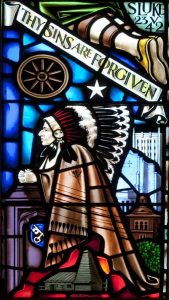 1918 – The Native American Church was organized in Oklahoma to combine an ancient Indian practice – the use of peyote – with Christian beliefs of morality and self-respect. The Church prohibits alcohol, requires monogamy and family responsibility, and promotes hard work. By 1923, 14 states had outlawed the use of peyote, and in 1940, the Navajo tribal council banned it from the reservation. In 1944, the Native American Church of the United States was incorporated. Today, the Church continues to play an important role in the lives of many Indian people.
1918 – The Native American Church was organized in Oklahoma to combine an ancient Indian practice – the use of peyote – with Christian beliefs of morality and self-respect. The Church prohibits alcohol, requires monogamy and family responsibility, and promotes hard work. By 1923, 14 states had outlawed the use of peyote, and in 1940, the Navajo tribal council banned it from the reservation. In 1944, the Native American Church of the United States was incorporated. Today, the Church continues to play an important role in the lives of many Indian people.
1919 – Indian veterans of World War I were granted citizenship.
1921 – On November 14th, the Cherokee Indians asked the U.S. Supreme Court to review their claim to one million acres of land in Texas.
1923 – On January 5, the Senate debated the benefits of Peyote for the American Indian.
Special Indian Commissioner H.J. Hagerman organized the first Navajo Tribal Council, which gave him the power to act for them in auctioning oil leases. The tribal government was established following the discovery of oil on its reservation.
1924 – The Indian Citizenship Act extended citizenship to all American Indians born in the U.S. on June 2, 1924. Some Indians, however, did not want to become U.S. citizens, preferring to maintain only their tribal membership.
Congress established the Indian Health Division to operate under the jurisdiction of the Bureau of Indian Affairs (BIA).
1928 – The Meriam Report, commissioned by the Department of Interior in 1926, focused on the poverty, ill health, and despair that characterized many Indian communities. It recognized that the Dawes Act was the cause of poverty on reservations, found boarding schools overcrowded and undersupplied with students underfed, and the schools’ unsanitary conditions giving rise to diseases. It recommended reforms that would increase the BIA’s efficiency and promote the social and economic advancement of Indians, the termination of allotments, and the phasing out of Indian boarding schools.
By this time, an estimated two-thirds of Native Americans had attended boarding school at some point in their life.
The Official US government policy is to terminate tribes. Many tribal governments were disbanded, and reservations were abolished.
1929 – On March 4, 1929, Charles Curtis served as the first Native American U.S. Vice President under President Herbert Hoover.
1934 – The Indian New Deal, the brainchild of BIA director John Collier, was an attempt to promote the revitalization of Indian cultural, lingual, governmental, and spiritual traditions. This blueprint for reform was written by non-Indians who felt they knew how to champion Indian rights.
The Indian Reorganization Act, the centerpiece of the Indian New Deal, encouraged Indians to “recover” their cultural heritage, prohibited new allotments, extended the trust period for existing allotments, and sought to promote tribal self-government by encouraging tribes to adopt constitutions and form federally-chartered corporations. To take advantage of IRA funding, tribes were required to adopt a U.S.-style constitution and were given two years to accept or reject the IRA. 174 tribes accepted it, 135 which drafted tribal constitutions. However, 78 tribes rejected the IRA, most fearing the consequences of even further federal direction.
The Johnson-O’Malley Act stipulated that the federal government pay states between 35 and 50 cents per day for Indian children enrolled in schools.
1941 – During the course of World War II, about 25,000 American Indians served in the armed forces, and another 40,000 Indian men and women were employed in wartime industries. Key among the American Indians participating in WWII were the Navajo and Comanche Code Talkers.
The Iroquois, Sioux, and Ojibwe (Chippewa) tribes declared war on Germany. The Iroquois Confederacy, having declared war on Germany in 1917, had never made peace and automatically became a party to World War II.
1942 – On January 9, 1942, a U.S. government press release said 40% more Native Americans had enlisted to fight in WWII than had been drafted. Altogether, 25,000 Indians served in the U.S. armed forces, including 800 women.
In the case of Seminole Nation v. United States, the court held officials of the United States were to be held to the “most exacting fiduciary standards” in performing their duties toward American Indians. Thus, it “has charged itself with moral obligations of the highest responsibility and trust” towards American Indian Nations.
1944 – The National Congress of American Indians was established when about 100 Indians met to create the nation’s first large-scale national organization designed to monitor federal policies. Today, over 250 member tribes throughout the U.S. work to secure that their descendants have the rights and benefits to which they are entitled, to enlighten the public toward a better understanding of Indian people, to preserve rights under Indian treaties or agreements, and to promote the common welfare of the American Indians and Alaska Natives.
California Indians were awarded $17 million that was promised in treaties nearly a century earlier. From that amount, $12 million was deducted for goods and services already given.
1946 – The Indian Claims Commission Act was created to do away with tribal grievances over treaty enforcement, resource management, and disputes between tribes and the U.S. government. Tribes were given five years to file a claim, when they had to prove aboriginal title to the lands in question and then bring suit for settlement. The Commission would then review the case and assess the amount, if any, that was to be paid in compensation. Until the Commission ended operations in 1978, it settled 285 cases and paid more than $800 million in settlements, largely for land claims.
On Nov 25, 1946, the Supreme Court granted Oregon Indians land payment rights from the U.S. government.
1948 – Trujillo v. Garley Supreme Court decision – In response to the allegation that many states had successfully prohibited Indians from voting, the Court ruled that states were required to grant Native Americans the right to vote.
Secretary of the Interior J.A. Krug signed a contract relinquishing Indian reservation land for the Garrison Dam in North Dakota.
1950s – Cherokee Admiral Joseph J. “Jocko” Clark rose to command the U.S. Seventh Fleet during the Korean War, making him the most powerful war chief in American Indian history.
1953 – Congress seeks to abolish tribes, relocate American Indians, and passes a federal termination policy, through which American Indian tribes will be disbanded and their land sold.
Public Law 280 transferred jurisdiction over most tribal lands to state governments in California, Oregon, Nebraska, Minnesota, and Wisconsin. Alaska was added in 1958. Additionally, it provided that any other state could assume such jurisdiction by passing a law or amending the state’s constitution.
To deal with increasing unemployment among American Indians, the BIA enacted a new policy to persuade large numbers of Indians to relocate to urban areas in 1953. Using the lure of job training and housing, brochures depicting Indian families leading a middle-class life were distributed by the BIA. While the initial response was enthusiastic, within five years, the relocation program was counted as a failure, with 50% percent of the participants returning to their reservations. This was the first of many late 20th Century failures to “mainstream” the Indian population.
1954 – Public Law 83-568 transferred responsibility for American Indians and Alaskan Natives’ health care from the BIA in the Department of Interior to the Public Health Services within the Department of Health and Human Services.
U.S. Congress voted to withdraw support to Wisconsin Indians. At this time, Menomonee Chiefs Oshkosh and Keshena met with federal Indian agents in Keshena Falls, Wisconsin, and agreed to retain only 275,000 acres from their original 9.5 million acres. The chiefs and their followers were promised eternal government protection as part of the settlement.
The 600-square-mile Garrison Dam in North Dakota, authorized by Congress in 1949, was completed. It covered the ancestral lands of Mandan, Hidatsa, and Arikara Indians.
1956 – The Indian Relocation Act establishes vocational training to encourage Indians to move off reservations. However, the plan fails due to weakened family ties.
1958 – On July 11, 1968, Monument Valley, straddling the Arizona-Utah border, became the first Navajo Tribal Park.
1961 – The National Indian Youth Council sought, and still seeks, to resurrect a sense of national pride among young Indian people and to instill an activist message – Indians were no longer to bow their heads in humble obedience to the BIA and other institutions of white society. Instead, they were to look back to their own great cultural traditions and make decisions based on such traditions.
1962 – The Lake Oahe reservoir in South Dakota, created by the US Army Corps of Engineers, reduced the Cheyenne River reservation of the Sioux Indians by 100,000 acres.
1964 – On March 9th, five Lakota Sioux Native Americans occupied Alcatraz Island in a peaceful protest. They declared that it should be a Native American cultural center and university.
The Economic Opportunity Act was passed that opened the gates for Indian management of their own affairs.
1965 – The Kinzua Dam on the Allegheny River opened in western New York. Construction of the dam forced the departure of Pennsylvania’s last Native Americans, the Seneca, who now live near Salamanca, New York, on the northern shores of land flooded by the dam.
1965-1973 – Vietnam War – At least 43,000 American Indians fought in the Vietnam War.
1968 – The Indian Civil Rights Act revised Public Law 280 by requiring states to obtain tribal consent before extending any legal jurisdiction over an Indian reservation. It also gave most protections of the Bill of Rights and the Fourteenth Amendment to tribal members in dealings with their tribal governments. It amended the Major Crimes Act to include assault resulting in serious bodily harm.
The American Indian Movement (AIM) was established shortly after the Minneapolis Anishinaabeg tribe formed an “Indian Patrol” to monitor police activities in Indian neighborhoods. The new organization was comprised primarily of young urban Indians who believed that direct and militant confrontation with the U.S. government was the only way to redress historical grievances and to gain contemporary civil rights; and that the tribal governments organized under the IRA (1934) were not truly legitimate or grounded in traditional Indian ways. By the 1990s, AIM was still active in Indian affairs but was less involved in the militant confrontation.
The story of the WWII code-talkers was declassified. American Navajo Indians had used their native language as code that the Japanese were unable to break. Chester Nez, the last Navajo code-breaker, died on June 4, 2014, at age 93.
The first tribal college, Navajo Community College (now Diné College), is founded in Arizona.
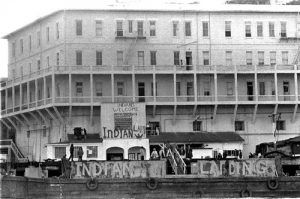
The dock at Alcatraz welcomes Native Americans after it was occupied. Photo by Michelle Vignes, courtesy of California State University
1969 – On November 20, 1969, “Indians of All Tribes” occupied Alcatraz, California. This occurred when a group of 80 Native Americans, all college students, seized the abandoned Alcatraz Island in the San Francisco harbor. They issued a “Proclamation to the Great White Father” stating their claim that Alcatraz was suitable as an Indian Reservation and, thus, should be converted into an Indian educational and cultural center. The occupation lasted 19 months, lasting until June 1971.
The 62-foot-tall Skowhegan Indian statue was built in Skowhegan, Maine.
On November 27, 1969, the United American Indians of New England began an annual National Day of Mourning at Plymouth, Massachusetts, on Thanksgiving Day to recall the disease, racism, and oppression the Pilgrims brought in 1620.
1970 – President Nixon makes a “Special Message on Indian Affairs” speech to Congress which denounced past federal policies, formally ended the termination policy, and called for a new era of self-determination for Indian peoples.
In May 1970, the U.S. government shut off power and stopped freshwater supplies from reaching the Native American Indians on Alcatraz Island. When a fire broke out, each side blamed the other.
On December 2, 1970, the US Senate voted to give 48,000 acres of New Mexico land back to the Taos Indians.
1971 – Congress approved the Alaska Native Claims Settlement Act. It gave large portions of prime bear habitat to the Alutiiq people, who had hunted and fished on the island for 7,000 years. This land, which comprised 10% of the state, was 44 million acres of land.
On June 10, 1971, Federal marshals, FBI agents, and special forces swarmed Alcatraz Island. It removed the Native American occupiers, which included five women, four children, and six unarmed men.
1972 – The Trail of Broken Treaties, a cross-country protest, was held when over 500 Indian activists traveled across the United States to Washington, D.C., where they planned to meet with BIA officials and deliver a 20-point proposal for revamping the agency and establishing a government commission to review treaty violations. When guards at the BIA informed the tribal members that Bureau officials would not meet with them and threatened forcible removal from the premises, the activists began a week-long siege of the BIA building. The BIA finally agreed to review the 20 demands and to provide funds to transport the activists back to their homes. Shortly after that, the FBI classified AIM as “an extremist organization” and added the names of its leaders to the list of “key extremists” in the US.
The Indian Education Act was established to fund special bilingual and bicultural programs, culturally relevant teaching materials, and appropriate training and hiring of counselors. It also created an Office of Indian Education in the US Department of Education.
1973 – On February 27, 1973, members of the American Indian Movement occupied the site of Wounded Knee in South Dakota, where, in 1890, Sioux men, women, and children were massacred. Before the occupation of the Oglala Sioux on the Pine Ridge Reservation in South Dakota, trouble had been brewing between the Indian activists who supported AIM and tribal leaders who had the support of the BIA. After a violent confrontation in 1972, tribal chair Richard Wilson condemned AIM and banned it from the reservation. In February 1973, AIM leaders led by Russell Means and about 200 activists who some Oglala traditional leaders supported took over the village of Wounded Knee, announced the creation of the Oglala Sioux Nation, declared themselves independent from the United States, and defined their national boundaries as those determined by the 1868 Treaty of Fort Laramie. The siege lasted 71 days when federal marshals, FBI agents, and armored vehicles surrounded the village. AIM members finally agreed to end their occupation under one condition – that the government convene a full investigation into their demands and grievances. During the siege, the Indians held at least ten hostages, and two AIM leaders were killed in the standoff.
1975 – Pine Ridge Reservation Shootout. In June, two FBI agents entered the Pine Ridge Reservation, ostensibly looking for a tribal member on theft and assault charges. Shots were fired under confusing circumstances, resulting in the death of the two agents and one AIM member. The violence that ensued was coupled with the criminalization of the AIM movement, the result of which was an undermining of the Indian movement for self-determination.

Aerial view of the Colorado River as it winds through the deep gorge at Grand Canyon National Park by Carol Highsmith.
On January 3, 1975, President Ford signed Public Law 93-620, which enlarged Grand Canyon National Park, as well as the adjacent Havasupai Indian Reservation, by 185,000 acres and designated a contiguous 95,300 acres of the enlarged National Park as a permanent traditional use area of the Havasupai,
On January 4, 1875, President Ford signed into law The Indian Self-Determination and Education Assistance Act that recognized the obligation of the U.S. to provide for maximum participation by American Indians in Federal services to and programs in Indian communities. This began the transfer of administration from the Bureau of Indian Affairs to the tribal governments.
Council of Energy Resource Tribes was established when leaders from over 20 tribes wanted to help Indians secure better terms from corporations that sought to exploit valuable mineral resources on reservations.
Leonard Peltier Arrest – Two years after the siege at Wounded Knee, conditions at the Pine Ridge Reservation had deteriorated. AIM activists and supporters continued to clash directly with tribal Chairman Wilson and his men. In 1975, two FBI agents were killed, and AIM activist Leonard Peltier was arrested, tried, and convicted for the deaths. Sentenced to double life imprisonment, Peltier’s arrest and conviction are still the subjects of heated controversy among many American political activists.
1977 – The Senate Committee on Indian Affairs was re-established. The Committee was originally created in the early 19th century but disbanded in 1946 when Indian affairs legislative and oversight jurisdiction was vested in subcommittees. The new committee became permanent in 1984, with its jurisdiction including studying the unique issues related to Indian and Hawaiian peoples and proposing legislation to deal with such issues that include but are not limited to Indian education, economic development, trust responsibilities, land management, health care, and claims against the U.S. government.
Report of the American Indian Policy Review Commission – The Commission, established in 1975, issued its report in which it called for a firm rejection of assimilationist policies, increased financial assistance to the tribes, and a reaffirmation of the tribes’ status as permanent, self-governing institutions.
The Iroquois Indians of North America began issuing their own passports.
1978 – On March 6, The U.S. Supreme Court, in the case of Oliphant v. Suquamish Indian Tribe, ruled that tribes could not try non-Indian defendants in tribal courts. It centered on the arrest of Mark Oliphant, a non-Indian, by tribal police.
The American Indian Movement led the Longest Walk, a spiritual walk from San Francisco to Washington, D.C., that lasted five months. Several hundred American Indian activists and supporters marched to protest threats to tribal lands and water rights. The Longest Walk is the last major event of the Red Power Movement.
On May 15, 1878, the U.S. Supreme Court decided in the Santa Clara v. Martinez case. When a Santa Clara woman married a Navajo, the tribal council denied her children membership in the Santa Clara Pueblo based upon a 1939 tribal ordinance that denied membership to children of women who married outside the tribe. The woman sued to grant membership to her children. The court’s decision held that tribal enrollment issues are an Indian-only matter immune from outside interference.
On August 11, 1978, the American Indian Religious Freedom Act was passed that promised to “protect and preserve for American Indians their inherent right of freedom to believe, express, and exercise “traditional religions”, including but not limited to access to sites, use and possession of sacred objects, and the freedom to worship through ceremonial and traditional rites. Although the enactment seemed to recognize the importance of traditional Indian religious practices, it contained no enforcement provisions.
The Indian Child Welfare Act, passed on November 8, 1878, addressed the widespread practice of transferring the care and custody of Indian children to non-Indians. It recognized the authority of tribal courts to hear the adoption and guardianship cases of Indian children. It established a strict set of statutory guidelines for those cases heard in state court.
The U.S. v. Wheeler Supreme Court Decision was a United States Supreme Court case in which the Court held the Double Jeopardy Clause does not bar the federal prosecution of a Native American who the tribe has already prosecuted.
The Federal Acknowledgment Project established the Branch of Acknowledgment and Research within the BIA to evaluate the claims of non-recognized Indian tribes for Federal acknowledgment. The project created a uniform review process for acknowledgment claimants with varying backgrounds and histories. In 1994, the Project regulations were amended.
1979 – The Seminole Tribe of Florida and Gaming was established. The Seminole were the first tribe to enter the gaming industry when they built a high-stakes bingo hall on their reservation in Hollywood, Florida. This was followed by a series of court battles leading to a final decision by the United States Supreme Court in 1981 that ruled in favor of the Seminole, affirming their right to operate their bingo hall. Their endeavors encouraged other tribes to begin gaming enterprises on reservations as a step towards greater economic self-sufficiency.
1980 – The United States v. Sioux Nation of Indians supreme court decision ruled that the Sioux Indians were entitled to an award of $17.5 million, plus 5% interest per year since 1877, totaling about $106 million in compensation for the unjust taking of the Black Hills and in direct contravention of the Treaty of Fort Laramie. The Sioux have refused to take the money and sits in a trust fund in Washington, collecting interest.
The Little Big Horn College was established in 1980 at the Crow Agency in Montana.
1981 – On July 9, 1981, the Lakota Times is first published from the Pine Ridge Indian Reservation in South Dakota.
1982 – The Indian Mineral Development Act encouraged Indian tribes to mine their lands in a manner that would help them become economically self-sufficient.
In the Seminole Tribe v. Butterworth Supreme Court Decision, the court ruled that tribes have the right to create gambling enterprises on their land, even if the civil statutes of the state prohibit such facilities. The ruling enabled reservations to establish casinos and gave reservations greater authority for tribal governments to levy taxes, own assets, and create judiciaries.
Maine Indian tribes laid claim to 60% of the state lands and settled for $81.5 million.
1985 – Wilma Mankiller becomes first female Chief of the Cherokee Nation.
1986 – The Mashantucket Pequot Tribal Nation opened its first bingo hall in Connecticut.
1987 – In California v. Cabazon Supreme Court Decision, the court effectively overturned California laws restricting gaming/gambling on U.S. Indian reservations. This win by the Cabazon tribe opened the door to Indian gambling nationwide. By 2015 almost half of America’s 566 Native American tribes and villages operated casinos.
1988 – in the Lyng v. Northwest Indian Cemetery Association Supreme Court Decision, the Yurok Indians and several other Northern California tribes argued that the construction of a six-mile, the two-lane paved road between the towns of Gasquet and Orleans and the implementation of a timber management plan would interfere with traditional tribal religions. The Court held that the construction of the road did not violate their freedom of religion.
The Indian Gaming Regulatory Act affirmed the right of tribes to conduct gaming on Indian lands but made it subject to tribal/state compact negotiations for certain types of gaming.
1990 – The Native American Languages Act made it U.S. policy to “preserve, protect, and promote the rights and freedom of Native Americans to use, practice, and develop Native American languages.” Consequently, the federal government encourages and supports the use of native languages as a medium of instruction in schools; recognizes the right of Indian tribes to give official status to their languages for conducting their own business; supports proficiency in native languages by granting the same academic credit as for comparable proficiency in a foreign language; and encourages schools to include native languages in the curriculum in the same way as foreign languages. Today, many American Indian languages have been lost; Indians currently speak less than 100 languages.
The Indian Arts and Crafts Act was passed to promote Indian artwork and handicraft businesses, reduce foreign counterfeit product competition, and stop deceptive marketing practices.
The Native American Grave Protection and Repatriation Act required all institutions that receive federal funds to inventory their collections of Indian human remains and artifacts, make their lists available to Indian tribes, and return any items requested by the tribes.
The Indian Law Enforcement Act created a unified approach to the BIA’s provision of law enforcement service on reservations.
President George H.W. Bush approves a joint resolution designating November 1990 as “National American Indian Heritage Month.” Similar proclamations have been issued each year since 1994.
1992 – The Mashantucket Pequot opened the first large casino in the United States — the Foxwoods Casino of Connecticut. At that time, it was the biggest gaming complex in the Western Hemisphere.
1996 – President Clinton authorized an Executive Order on October 21 on Tribal Colleges and Universities, the U.S. Department of Education, to continue supporting and developing tribal colleges into the 21st Century.
Elouise Cobell, a Blackfeet woman from Browning, Montana, filed a lawsuit alleging that the US Interior Department mismanaged billions of dollars held in trust by the government. In 2010 the US House of Representatives approved a $3.4 billion government settlement.
1998 – The Nez Pierce tribe returned to its ancient homeland in Oregon after 121 years of exile.
1999 – Shannon County, South Dakota, home of the Oglala Lakota on Pine Ridge Reservation, is identified as the poorest place in the country.
2000 – The U.S. Mint issues a dollar coin with the image of Sacagawea.
On January 14, 2000, the federal government announced the return of 84,000 acres in northern Utah to the Ute Indians. The land was taken in 1916 for the rights to oil shale reserves.
On September 8, 2000, the Bureau of Indian Affairs marked its 175th birthday and Kevin Grover, head of the bureau, offered a formal apology to American Indians for the agency’s misdeeds.
In December 2000, the Timbisha Shoshone Indians were granted 7,600 acres around Death Valley, including 314 acres within the national park.
2002 – Chickasaw Indian Jack Bennett Herrington becomes the first Native American in space.
2004 – The National Museum of the American Indian opens in Washington, D.C.
2005 – The National Collegiate Athletic Association bans the use of “hostile and abusive” American Indian mascots in postseason tournaments
2008 – The Coquille Indian Tribe on the southern Oregon coast adopted marriage equality policies, the first tribal nation to do so openly in the United States.
On August 7, 2008, a U.S. federal judge ruled that American Indian plaintiffs were entitled to $455 million, a fraction of the $47 billion they sought in a one-year trial for alleged losses on royalties overseen by the Interior Department since 1887.
2009 – President Obama signs Native American Apology Resolution
The Federal government agrees to a $3.4 billion settlement with Indians who say they were swindled out of royalties overseen by the Department of the Interior since 1887.
2010 – On December 8, President Obama signed legislation to pay American Indians and black farmers some $4.6 billion for government mistreatment over many decades. The legislation settled four long-standing Native American water rights suits in Arizona, New Mexico, and Montana.
There are 5.2 million Native Americans and Alaska Natives recorded in the 2010 census. Michigan is one of the ten states with the highest recorded Native American populations.
2012 – The HEARTH Act allows tribal governments to approve the leasing of tribal lands.
“Being Indian is an attitude, a state of mind, a way of being in harmony with all things and all beings.”
– Brooke Medicine Eagle
Compiled and edited by Kathy Alexander/Legends of America, updated February 2024.
Also See:
Adventures in the American West


